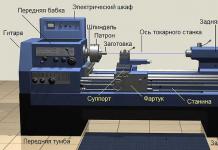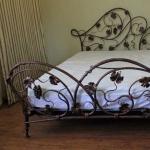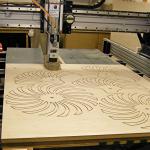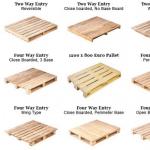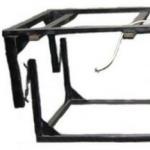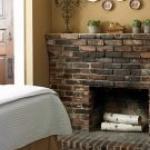Paper wallpaper is an opportunity to create an interior in any style without tangible costs for the budget. The design variability of such canvases is incredible - there are simple and discreet motifs, and there are luxurious canvases created by hand, in much the same way as artists paint their masterpieces on canvas. It is difficult not to find a suitable pattern in a wide range, but it is important to know which coatings are suitable, how to choose and glue them correctly.
Advantages and disadvantages of paper wallpaper
If you hear, when choosing paper wallpapers, that this is an impractical and low-quality material, do not forget to clarify which manufacturer was in question. The thing is that the leading German, Italian, French brands choose paper for many of their design collections, including children's ones. And, therefore, certain advantages of these canvases are still present:
- affordable price combined with a stylish appearance;
- environmental friendliness - the walls will breathe, which means that a wonderful microclimate will remain in the room;
- absolute security;
- economy, ease of use.
Of course, there were some drawbacks, and the most important among them is the low service life of 5 years maximum. But if you wish, you can easily turn it into dignity - for example, for a children's room, you can choose the best paper wallpapers for each of the child's growing up periods, and change the interior without regretting expensive coatings.

Types and characteristics of coatings
You will be surprised, but on paper wallpapers, the characteristics may differ significantly, since there are several types of this coating:
- smooth, with a typographic pattern on the surface or simplex paper wallpaper. They can be very decorative, but are only suitable for rooms with low humidity. Very thin, but cheap, with good moisture and vapor permeability. They require careful preparation of the base, since they do not hide the original irregularities;
- paper duplex wallpaper - a better and more durable option, where two layers of paper are used, the top of which is decorated. They are easy to use, because even when wet from glue they do not tear. Can be smooth or embossed;
- embossed paper wallpapers - also two-layer, but the pattern is applied by embossing;
- foam wallpapers - with an acrylic "volumetric" top layer. They can be washed as they are waterproof. The acrylic layer is applied “dotted”, so that the wallpaper will “breathe”;
- with a moisture-resistant coating, two-layer paper wallpapers with a special protective layer of varnishes or latex, thanks to which the coatings can be subjected to wet cleaning;
- paper wallpaper on a paper basis for painting as one of the varieties of duplex. Designed for repeated staining, but quickly lose their relief.

It is impossible to say how to choose paper wallpapers and how to glue canvases without seeing the interior of the room, without taking into account the area, the location of windows and the level of illumination. There are only a few universal recommendations regarding colors - it is advisable to follow them in any case:
- soft tones soothe, and bright colors give dynamism, but in large quantities they can irritate;
- rich dark shades are suitable if the windows in the room are south. These are terracotta, chocolate, coffee and sapphire;
- for the northern windows, light colors are selected - green, lilac, yellow;
- the smaller the drawing, the farther the walls will appear from each other;
- if you choose a large pattern, make sure that it is soft, not flashy;
- to change the perception of a room, use vertical or horizontal stripes.

Do not forget to also correctly calculate the number of wallpapers, taking into account the area of \u200b\u200bthe room and the rapport of the pattern. And make sure that all the rolls you purchase belong to the same batch - otherwise there may be inconsistencies in tone that will definitely appear on the walls.
Rules for pasting paper wallpaper
There is nothing difficult in how to glue paper wallpapers correctly. The main thing is to purchase glue for light wallpaper and prepare it in accordance with standard requirements - 5-7 liters of water per pack of dry glue. The glue is thoroughly mixed and left to swell, while making sure that no lumps remain in the mixture.
Canvases are glued on a pre-leveled putty and primed surface. Do not forget that the paper gets wet, and therefore all work is carried out very carefully. To coat the strip, use a brush or roller.
Do not forget that paper wallpapers “shrink” when dried, so the canvases will certainly be glued with an overlap, with an allowance of up to 5 mm. The sequence of work is as follows:
. walls are pasted over with canvases in the direction from the window to the door;
. at the next stage, the areas near the window, door, under the windowsill are pasted over.
And do not forget to control the coincidence of the pattern, and also do not allow a draft until the coating is completely dry.

By following the rules of gluing and carefully combining the pattern, you will get the perfect result!
Caring for paper wallpaper
Before washing paper wallpapers, you need to make sure that the coating belongs to a moisture-resistant "family". If there is a protective coating on its surface, then the dirt can be wiped off with a damp sponge with foam, but streaks should not be allowed.
Grease stains can only be removed from the surface if they are fresh. Therefore, in places of frequent contact with hands - for example, near switches, protective pads are made. And you can try to erase other dirt with a regular eraser. But do not forget that you still will not provide special durability of these coatings - sometimes it is advisable to completely replace the wallpaper, and not try to wash it off.

Nowadays, paper wallpapers remain the most popular because of the low price and huge selection of color palettes. This type of wallpaper is environmentally friendly and does not contain any harmful impurities in the composition, so they are very popular among people with certain respiratory diseases and various types of allergies.
Paper wallpapers are the undisputed leaders in their segment, and a large selection of colors and patterns encourages the consumer to draw attention to themselves. It is because of these factors that manufacturers have to come up with more and more types of paper wallpapers, but Simplex and Duplex are considered the most common.
Simplex
Wallpapers of the Simplex type are distinguished by excellent smoothness and a small thickness of the sheet. Such wallpapers are divided into two types, single-layer and double-layer. The first type has the front side covered with a pattern, and the lower part which is the substrate. In the second view, the drawing is applied typographically on both sides.

What are the advantages:
- Large selection of color palette;
- Excellent water permeability;
- Fairly low price.
But such wallpapers also have significant drawbacks:
- High probability of damage when applied to the wall;
- Discoloration;
- There must be a perfectly flat surface;
- fragility.
Duplex
Duplex wallpapers have two layers at the base, where one is the upper part with a pattern, and the lower one, which plays the role of a substrate. During the production of such wallpapers, the upper part is initially created, and after that it is connected to the bottom, which makes the wallpaper stronger. Duplex wallpapers also have excellent smoothness, but embossed patterns are also possible.

The advantages of such wallpapers:
- Slow fading, subject to the application of a certain composition;
- Perfectly hides irregularities in the wall;
- Compared to single-layer wallpaper, more durable.
But they also have significant disadvantages:
- Under the influence of glue, relief may be disturbed;
- As in the first option, there is a high probability of damage when applied to the surface;
- Little wear resistance;
- High price.

Also wallpaper "Duplex" are used for painting, they are mostly white. An example of such wallpaper:
- Structural;
- fibrous;
- Moisture resistant.
As a result, paper wallpapers have a huge selection and a wide range of prices, where everything depends on the number of layers and the quality of the material.
Textile wallpapers
Textile wallpaper has a paper base, the bottom layer is made from non-woven fabric. The peculiarity of such wallpapers lies in natural materials, they also have excellent visual appeal.

Advantages of textile wallpaper:
- Possess soundproof parameters;
- Good wear resistance;
- Not affected by sunlight;
- Good durability in use.
Cons of textile wallpaper:
- The probability of erasing the pattern with frequent touch;
- It is difficult enough to stick on the surface;
- High probability of accumulation of dust and other particles;
- Inadmissibility of wet cleaning;
- High price.

Nowadays, textile wallpapers are divided into several varieties:
- Silk;
- Jute;
- Linen;
- Velor;
- Felt.
Due to moderately high prices, textile wallpapers cannot be afforded by an economy class consumer.
Wall mural
In the production of photo wallpapers, a paper base is used, on which a photo image is subsequently applied. Wall murals are easy to get dirty, there is a high probability of mechanical damage during use, they are prone to fading when exposed to ultraviolet radiation. To improve the quality, acrylic, varnish, or compositions similar in properties are applied to the wallpaper.

What are the advantages of photo wallpaper:
- Excellent decoration of the room;
- Low price.
Considered disadvantages of photo wallpapers:
- It does not mask even the slightest irregularities at all;
- Difficult to stick.
Due to the relatively low price and high color palette, photo wallpapers can appeal to even the most picky consumers.

In custody
The article shows the most popular types of paper wallpapers that can be found in the yusi.com.ua catalog. An important criterion when choosing, do not forget about what final function the room will carry. After summarizing the design, it will be much easier to choose such a wide variety of wallpapers.
Don't miss interesting news in photos:


Best Sweet Gift Ideas for New Year 2019
How to make glowing water
Unusual lighting in the interior
12 original ideas on how to convert old furniture into stylish interior items
Apparently, evaluating, most people come to the conclusion that the pros are much more significant than the minuses. To be convinced of this, it is enough to visit a few acquaintances and friends. Worldly wisdom plays an important role in the choice - an old friend is better than two new ones. Still, Russians have been using inexpensive materials for walls for over 150 years.
Modern types of paper wallpaper
The current types of paper canvases are as similar to their ancestors as a cart is to a modern car.




Manufacturers filled stores with a variety of models:
- Classic single-layer (simplex) with a smooth or embossed surface. The canvases are thin, so they often tear during gluing and during accidental mechanical stress. Fades quickly in sunlight.
- Paper wallpaper duplex. Thanks to 2 layers, their strength is higher, but also short-lived. They cost more than a simplex, the possibility of wiping with a damp cloth is allowed, but there is a risk of damage to the front layer after drying.
- with a white or one-color surface. With infrequent repainting, the service life is up to 7 years.
- Moisture resistant, varnished or latex coated. Despite the decent cost, there is no texture, but such models are washed with soap and water.
- Three-layer (triplex). Expensive, but otherwise - only pluses - durable, moisture resistant, resistant to repainting, mask wall defects.
- Structural or wood fiber, in which a layer of wood chips is placed between two layers of paper, creating the texture of the outer layer. The cost is decent, but the performance parameters are high with a wealth of decorative solutions.
- Acrylic-coated paper sheets, or foam wallpapers, their front layer is dotted with acrylic polymers. As a result, relief patterns are obtained, which allows you to hide minor flaws in the walls.
The strength of the material by density is indicated on the label. The most durable from 140 g / m2.
Paper wallpaper in interior design





Knowing the features of paper wallpaper, with the right choice of color, pattern, texture, you can create a design that is not inferior to design using. By choosing the right color and pattern, you can make the room lighter or darker, visually raise or lower the ceiling, change the dimensions, change the temperature by several degrees. When choosing a color, you should follow the recommendations of psychologists:
- pastel colors create a calm atmosphere;
- light beige shades can visually enlarge the space;
- to stimulate vivacity, you need to use yellow or orange flowers;
- gold and silver colors will create a festive look, but in moderation;
- in case of poor lighting of the room, bright colors should prevail in it;
- the combination of red and pastel colors has proven itself well in workplaces and living rooms;
- the use of purple in large rooms visually reduces their size, but, paradoxically, in small rooms it increases;
- blue color and its shades are used not only to visually enlarge the room, but also to create a calm atmosphere;
- green creates conditions for relaxation, as it calms the nerves;
- a black and white palette is used by people with a reinforced concrete nervous system or completely deprived of it.
Despite the fact that the fashion for ornaments changes, spatial and aesthetic laws remain unchanged. Vertically striped paper canvases increase the height of the ceiling, while horizontal stripes increase the width and length of the room. Strange, to put it mildly, wallpaper with large or small patterns of flowers will look in a small room. Bright colors should be diluted with pastel colors to reduce eye strain. on a paper basis with landscapes will decorate any room.
The larger the drawings, the softer the colors should be.
Paper wallpaper for walls: pros and cons





The secret of the popularity of this coating is due to the abundance of its advantages:
- small price;
- environmental Safety;
- possibility of application in any premises;
- does not cause allergies;
- a rich selection of colors, ornaments, textures;
- varieties with a protective coating allow;
- ease of sticker and care;
- breathability.
The main disadvantages of paper wallpaper include low strength and wear resistance. Soundproofing and thermal insulation are practically absent. Rapid burnout and abrasion of the pattern are also not the best sides. The service life is usually up to 3 years, but with careful handling and proper care, some models can reach up to 10 years.
Scope of application




The characteristics of the finish make it possible to use it not only in all residential areas, but also in offices, hospitals. Since this finishing material is the most environmentally friendly, it is most often used for finishing living rooms, bedrooms, children's rooms.
Excellent breathability allows you to maintain the microclimate in them at the proper level without additional effort. Even in the case when children use all the coverage space available to them to demonstrate their artistic talents, its replacement will not be burdensome for the family budget.
As soon as variations of moisture-resistant paper wallpapers appeared, they immediately began to be actively used in bathrooms, hallways, and especially in kitchens. In bathrooms, they are mainly used as a colorful addition to the main finish. Good air permeability of the material does not allow mold and fungus to start. Therefore, in the kitchen, where they like to settle, there is no unpleasant smell.
Since budgetary organizations and businessmen save money for various reasons, the walls of most of their offices are finished with paper wallpaper. Cheap and beautiful!
The master, unlike the beginner, knows 1000 little things in his business, so you need to listen to the advice of the masters. This will not only do the job efficiently, but also save time and money.
- When buying wallpaper, you should stock up on a couple of extra rolls. They are useful when replacing damaged or heavily soiled areas.
- Paper tends to shrink when dried, so the canvases are glued with an overlap with an overlap of 0.5 cm.
- You need to purchase wallpaper glue from reliable sellers, having collected information about the brand and parameters in advance.
- So that paper wallpapers do not have time to become limp when they are smeared with glue, you need to work together.
- Having pasted 4-5 strips, it is necessary to remove the indents until the glue has hardened. This will be difficult to do later.
- Do not glue the corner with a solid canvas. It is easier to cut it along with an allowance of 2 cm from the bend. On the next wall, 1 strip is glued plumb.
- The sticker must start from the window so that the joints do not create a shadow in daylight.
- When gluing new canvases on old ones, it is necessary to carefully glue the edges of the old canvases with glue. Otherwise, the new ones will not fit snugly and may peel off.
- In order to avoid deformation of the freshly glued paper covering in the room, do not open windows for 2-3 days so that drafts do not occur.
Specialization: philological education. Experience as a builder - 20 years. Of these, for the last 15 years he led a brigade as a foreman. I know everything about construction - from design and the zero cycle to interior design. Hobbies: Vocal, psychology, quail breeding.
Greetings, my dear readers.
Construction technologies do not stand still and almost every year new, modern types of rolled wall cladding materials appear. But the good old paper wallpapers do not lose their popularity so far.
This happens due to their cheapness, which does not hit the family budget, if necessary, refresh the interior of the home. In addition, paper wallpapers are easy to remove and replace with new ones on your own. You don't need to hire professionals for this.
Paper lining: 5 types
Paper based wallpapers are traditional and have been used for many decades. There are several types:
| Image | Type of paper wallpaper |
 |
Simplex.
These are smooth panels made from a single layer of paper. Patterns and drawings are applied to the front side of the material using the typographic method. Low-grade paper is used for inexpensive finishing models. In the production of premium analogues, a special light-resistant primer is used. It protects the lining from fading. Abroad, simplex paper wallpapers are no longer made. However, in Russia they are produced by several factories. |
 |
Duplex.
These are double layers. First, a pattern is applied to the front side, then it is firmly glued to the base. There are several duplex options. One of them is laminated embossed wallpaper. The drawing on them is squeezed out after gluing the layers. In this case, the image on the panels turns out to be more convex and aesthetic. |
 |
Structural canvases.
This is a dense, durable, multi-layered finish. The material is additionally impregnated with a moisture-proof composition. Due to the increased thickness of the canvases, there is no need to carefully smooth the walls under them, as they mask small irregularities. |
 |
Wall mural.
These are segments of canvases, parts of large integral images are printed on them. Modern paper photo wallpapers can have a 3D effect. |
 |
Wallpaper for painting.
These are rolls of white porous paper. Most often, a small pattern is squeezed out on it. Such lining can be painted several times in any chosen color. Water-dispersion paint is best suited for this. |
Duplex is more practical and of higher quality than simplex. Before sticking them, an adhesive composition is applied to the wallpaper panels, then the canvases are straightened on the base.

In this case, the wetted single-layer paper linearly expands (stretches), and when dried, it contracts. This leads:
- to the distortion of patterns on the finish:
- inaccuracies of fitting along the edges of the panels;
- the formation of air bubbles;
- occurrence of divorce.
When using duplex, these problems do not appear. The adhesive impregnates only the base, the front layer of the canvas remains dry. This stops the expansion of the material.
Characteristics of paper wallpaper
Paper wallpaper has its pros and cons.
Material Advantages

- The main advantage of paper-based wallpaper is their diverse range. Foreign and domestic manufacturers offer hundreds of models of panels with a variety of colors, textures and patterns. Thanks to this, it is possible to equip the interior with their help in any style and color design.
- Paper wallpapers for walls are an environmentally friendly material. They are made from natural ingredients. Adhesives for panels are also chemically harmless.
- The paper is vapor and breathable. Therefore, wallpaper from it helps to establish a healthy microclimate in the premises.
- This finish is inexpensive. That allows you to save on repairs.

Another significant advantage of wallpaper is its ease of use, it does not require special skills and knowledge:
- First of all, you need to prepare the base: remove the old finish and, if necessary, level the surface. Then putty and primed the walls.
- After the glue is spread over the panels, it is necessary to leave them for 15-20 minutes. During this time, the fixative will saturate their base.
- After gluing, the canvas should be gently smoothed with a rag or roller to remove air bubbles and glue that has come out.
- It is advisable to finish the walls with wallpaper together. This will simplify and facilitate the process.
Disadvantages of panels

The cons are:
- Paper canvases are not particularly durable, which distinguishes them from their non-woven counterparts. They should be treated with care. In this case, the finish cannot be completely cleaned of dirt.
Simplex and duplex have different degrees of strength. The first type is easily torn and dirty. The second type has increased durability properties.

- Painted paper is afraid of sunlight. She fades and fades from them. Therefore, the printing drawing and self-painting on the wallpaper from it lose their aesthetics after a few years.
- Paper panels have a low level of sound insulation. Therefore, such a cladding practically does not absorb street and domestic noise.
- The material is not waterproof. Wallpaper made of paper is suitable only for dry rooms: hall, bedroom, nursery, office. It is highly undesirable to use them in the bathroom, toilet, hallway and kitchen.
- Paper is a combustible material. Is it possible to cover such a finish with a fire-retardant compound? The answer is positive. But this will not change the situation.
Due to all its shortcomings, paper trim is short-lived. The simplex has a lifespan of about 5 years. For duplex and structural panels, thanks to additional protection, it can be 10-12 years.
Material selection
Often choosing paper or non-woven wallpaper, users prefer the former because of their aesthetics and low cost. Therefore, despite all their disadvantages, they remain very popular.

When purchasing material, it is important to heed the advice regarding the color design of the finish. Here are my recommendations:
- Delicate pastel colors of the cladding will bring an aura of peace, tranquility and confidence into the room. Bright colors (red, orange, yellow) have an exciting and irritating effect on the psyche.

- When choosing panels, you should take into account the location of the room relative to the cardinal points. In the southern room, you can use wallpaper in rich shades of dark colors (blue, chocolate, coffee, terracotta, etc.). Such a finish will absorb an excess of light energy.
In the northern room, the lack of sunlight is able to compensate for light-colored finishes (light green, blue, beige, pink, white, etc.). Then visually the room will be 1.5 times brighter.
- It should be remembered that dark colors narrow the space, while light colors expand it.

The pattern on the wallpaper is also important:
- Cloths with small patterns and images or solid colors visually expand the space. Based on this, they are best to paste over small rooms. In addition, blood and dirt cannot be removed from the paper. Small patterns mask them.
- Volumetric drawings visually compress space. The larger they are, the lighter their color should be.

- Vertical stripes on the cladding visually make the room taller, while horizontal stripes expand it.
When choosing a finish, also pay attention:
- on the texture and texture of the canvases, they can be smooth, embossed, corrugated;
- on the operational characteristics of wallpaper: their categories for density, water resistance, classes for vapor permeability and light resistance;
- purpose: the material can be wall or ceiling;
Conclusion
Paper wallpapers have not lost their relevance for many decades. This budget cladding is quite aesthetic and helps to equip a stylish interior. If you choose duplex wallpapers, they will last a long time.
You might still have questions, you can ask them in the comments. I say goodbye and good luck in your endeavours.
January 10, 2018If you want to express gratitude, add a clarification or objection, ask the author something - add a comment or say thanks!
Who among us has not come across inherited walls on which paper wallpapers were pasted?
Time passed, the pattern, style, texture changed, but the very essence of paper wallpaper remained the same. And now, you should not treat them as a relic of the past, which you want to get rid of as soon as possible. In fact, the modern construction market offers you such a wide and rich assortment of paper wallpapers that there is definitely something to choose from!
To begin with, let's define what paper wallpaper is, and also consider the main features of paper wallpaper.
Paper wallpaper is a special rolled material that is used for wall decoration. As the basis of paper wallpaper, there are various types of paper, and if you look even deeper, then different types of wood.
Varieties of paper wallpaper and some basic advantages of paper wallpaper- this is what will be discussed below.
Despite the fact that there is a fairly large number of paper wallpapers, it is possible to distinguish among them the main features by which the classification of paper wallpapers is carried out.
A common element for all varieties is, of course, the structure of paper wallpapers. According to manufacturing technology, they can be divided into 2 types: simplex - wallpaper and duplex - wallpaper. Simplex is a wallpaper that is made with one layer of paper, on which, directly, the drawing is applied. And duplex - wallpaper - these are wallpapers that are made of two or more layers. As a rule, duplex wallpapers, in addition to one main (base) layer, also have an additional coating that protects them from various possible contaminants, defects and other influences. Sometimes, among duplex wallpapers, you can find models that have thermal insulation, sound and noise insulation. Also, pay attention to textile wallpapers in the interior, they look very impressive.
Also, simplex paper wallpapers can be divided into: simple and structural. Both of them have certain pros and cons of paper wallpaper.
Simple wallpaper (smooth paper wallpaper) is a type of wallpaper, one layer of which is made on the basis of paper; those. one side they are glued to the wall, and on the other side there is some pattern or pattern. Printing of such wallpapers is carried out in special printing houses. It should be noted that among smooth paper wallpapers there are those that are painted by hand. Such wallpapers are a product of the highest class, and, of course, are many times more expensive.
Structural wallpaper- these are wallpapers that are glued to the wall on one side, and on the other side there is a special embossed pattern or pattern, which is achieved by the fact that the three-dimensional pattern is achieved using a special rotary screen printing method. After such wallpapers are pasted on the wall, outwardly they are somewhat reminiscent of decorative textured plaster, which also has a three-dimensional pattern. Very often, structural simplex wallpapers are produced in the usual white color, that is, for painting. Further, the fantasy and imagination of the owner of the premises come into play.

As for duplex wallpapers, they are wallpapers that are glued to the wall on one side, and the other side (more precisely, the second top layer) is embossed. Corrugated wallpaper, which is printed using a special flexographic method, will look very rich. Also, it should be noted that duplex wallpaper can also be divided into several types:
- Embossed duplex wallpaper
- Roughly structural duplex - wallpaper
- Fibrous duplex - wallpaper
Paper wallpapers: pros and cons
To the main advantages and advantages of paper wallpaper can be attributed:
- Ease of manufacture
- Relatively low price. In fact, a very important factor, especially when you consider that some people like to change the situation in their home often.
- A rich assortment of proposed drawings, patterns - which allows you to choose exactly the color that best suits the rest of the interior details.
Paper wallpapers: cons
The main disadvantages of paper wallpaper include the following:
- They quickly fade, lose their freshness.
- Fast abrasion
- Inability to clean them with wet products (only dry cleaning is allowed).
In general, no matter which wallpaper you choose, know that paper wallpapers will fit perfectly into the interior; especially if you correctly and competently think over the future design of the room!

